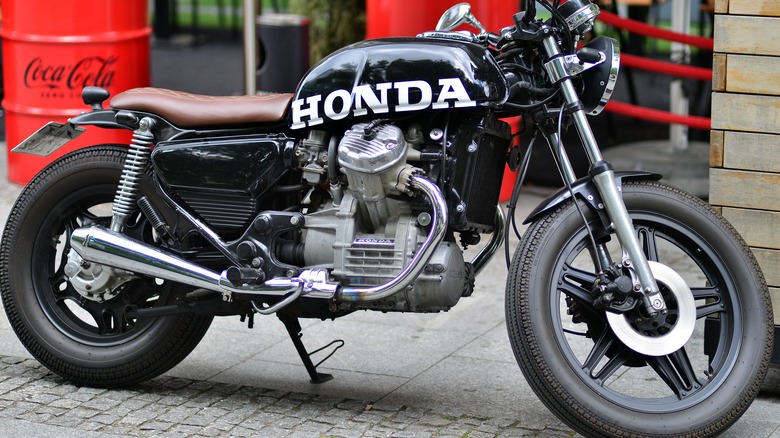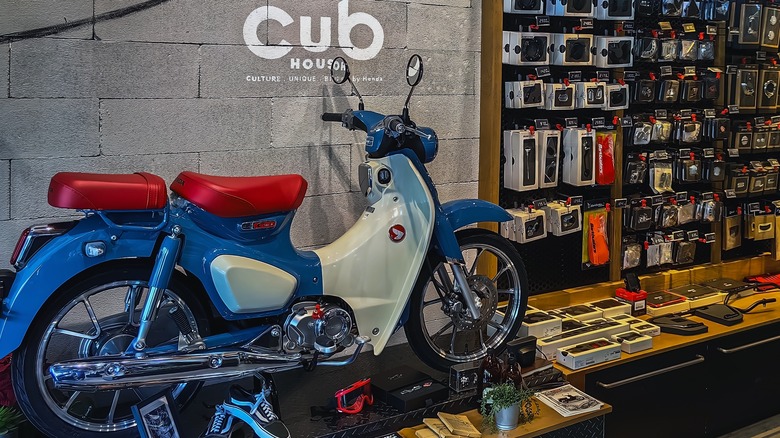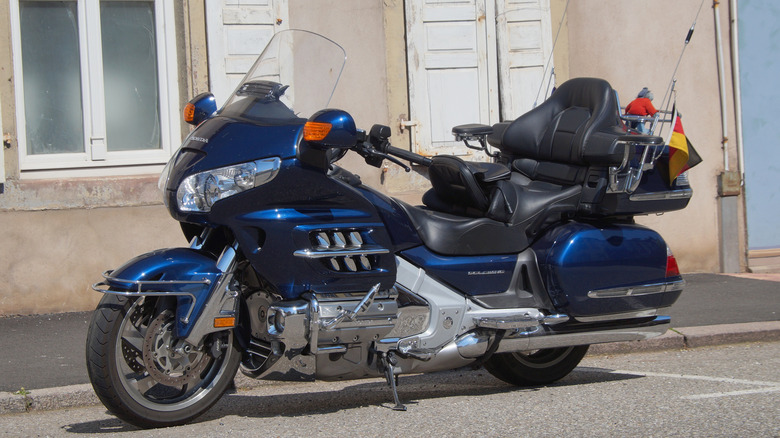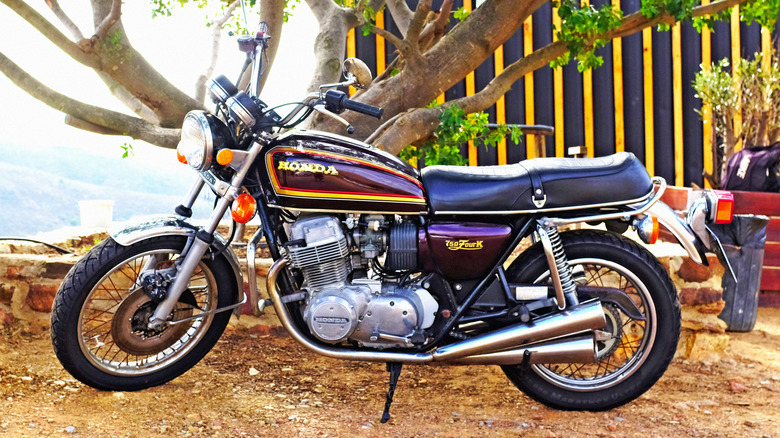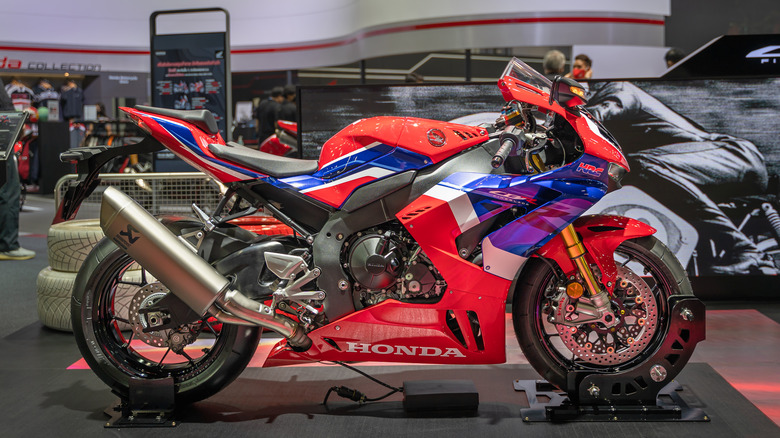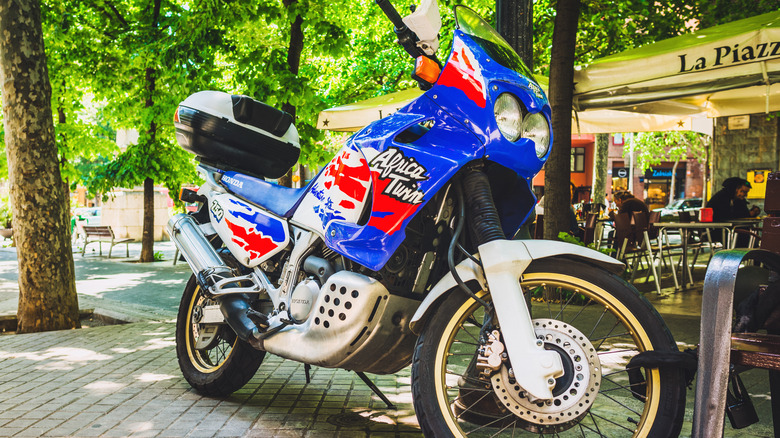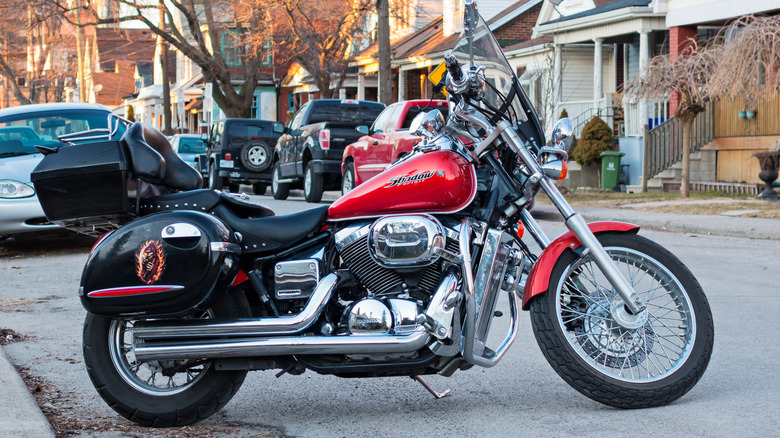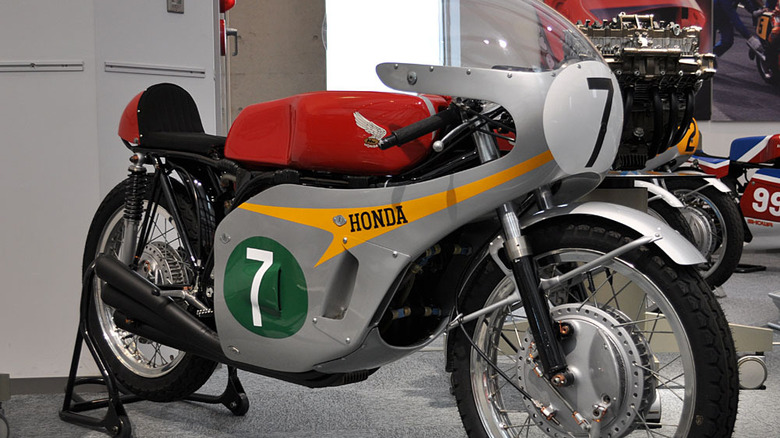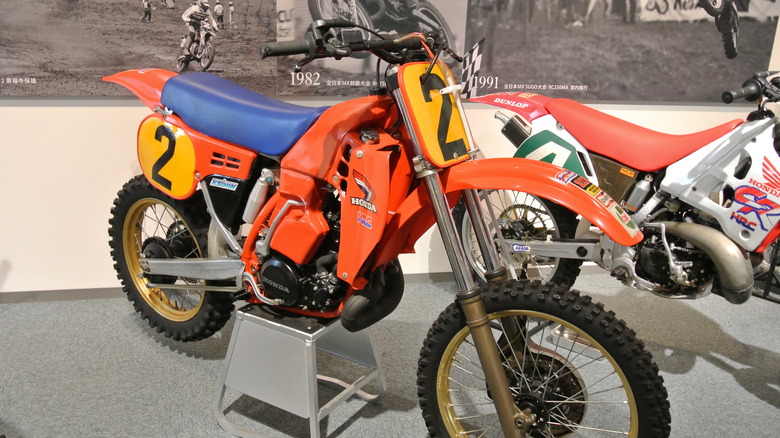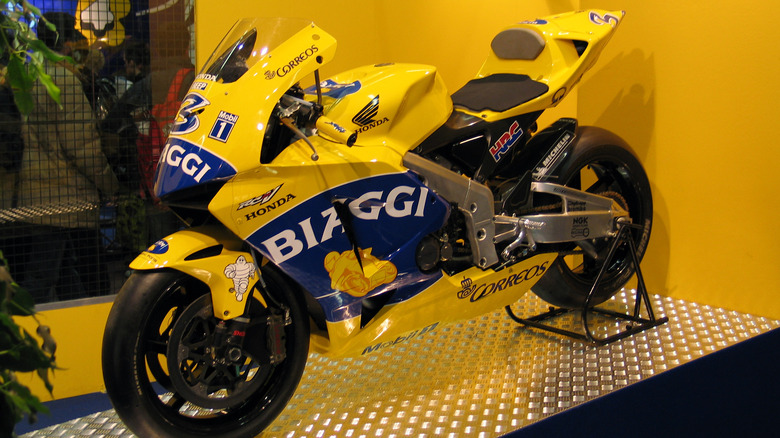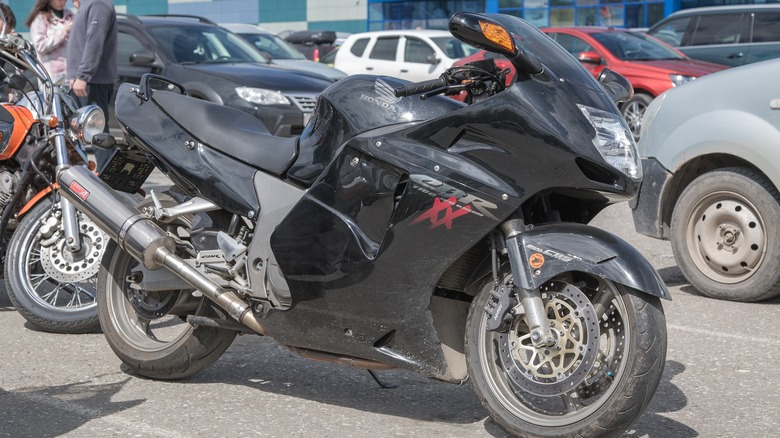10 Of The Most Successful Honda Motorcycles In History
The Honda Motor Company, a versatile powerhouse in the automotive industry, has produced quality automobiles for over 75 years. However, it's not as well known that the Honda Motor Company's first original product was a motorcycle.
Company founder Soichiro Honda recognized a need for reliable and cheap transportation in Japan during the post-World War II fuel and material shortage, so in November 1947 Honda unveiled a motorized bicycle known as the A-type. With a teardrop gas tank and a diminutive two-stroke engine, the A-type was barely the same species as the beefy Harley-Davidsons, Nortons, Indians, and Triumphs thundering overseas. While its status as a proper motorcycle may be debated, one thing is undeniable: The A-type was the spark that ignited the Honda flame.
Over the next three-quarters of a century, the Honda Motor Company would build some of the best-selling, best-performing, and most impactful motorcycles the world has ever seen. Whether screaming around a MotoGP track, cruising down a lonely highway, or shifting the paradigm of what a motorcyclist could be, it's been a successful ride for Honda.
Success is subjective. When it comes to auto manufacturers, it can come in the board room, on the racetrack, or in the cultural zeitgeist. Let's look at some of the most successful Honda motorcycles in history, whether measured by sales numbers, race podiums, sheer reliability, or cultural impact.
Honda Cub
What better way to start a list of successful motorcycles than with the best-selling bike of all time? By the 1950s, Honda was firmly entrenched in the motorcycle game. It had come a long way from the Type A, introducing the 100cc to 350cc Dream D and E models, and the 125cc Benly. Honda executives sought a project that could take the primarily domestic motorcycle builder international.
A trip to Europe showed Honda president Soichiro and managing director Takeo Fujisawa the way. Upon their return to Japan, they instructed Honda's development teams to create a bike with a high-powered four-stroke engine, light and handleable enough for women to operate, a clutchless shifting method, and a timeless design.
The result was the 1958 Honda Super Cub C100, a 49cc commuter vehicle that was easy to use, inexpensive, reliable, and filled the gap between mopeds and full-sized motorcycles. Fujisawa determined that Honda must sell 30,000 monthly units to cover production costs. A thousand units went out the door on the first day. Honda ramped production up to 60,000 per month and hasn't looked back.
Two updated editions appeared in the first decade of production. 1981 Honda released the 105cc Super Cub CT110 for off-road use. The biggest and most recent Super Cubs are equipped with 125cc engines and remain an internationally utilized commuter bike. From a small beginning, the little bike has become the most purchased motorcycle in history, with over 100 million units sold by Honda.
Honda Gold Wing
Honda has sold motorcycles across the market spectrum, from the most popular commuter scooter in the world, the Cub, to the world's first superbike, the CB750. Blistering speed and convenient commutes are one thing, but access to every vehicular comfort imaginable aboard a motorcycle is a particular pleasure.
The Gold Wing debuted to acclaim at the 1975 Cologne motorcycle show and has served as Honda's flagship luxury motorcycle ever since. With a liquid-cooled 1000cc engine, the original looks bare bones compared to modern models. The bike was an instant success as an ultra-smooth and powerful comfort cruiser. Thanks to riders wishing to make the smooth GL a long-distance tourer, an aftermarket developed.
Honda recognized the demand and pivoted. The second generation hit in 1980 and was an evolutionary step toward full touring glory. Still, it wasn't until 1984 that the Gold Wing GL 1200 aimed squarely at comfort, adding a windscreen, fairings, radio, air suspension, and luxurious padded seating.
Today's sixth-generation Gold Wing is a model of modern motorcycle technology. A single overhead cam 1,833cc flat-six delivers a silky 98 horsepower through either a six-speed manual or automatic transmission. All the modern bells and whistles are present: traction control, ABS, hill start assist, an infotainment screen, and more.
Honda still stays fairly close-lipped about production numbers, but a 2011 Washington Times article pegs the number of Gold Wings sold at about 640,000. Add another decade's worth of contented touring fans to that, and we're talking about one seriously successful motorcycle.
Honda CB750
The CB750 is just one part of the enormously successful CB line Honda has put out over the years. In the conversation as the world's first superbike, the classic CB750 remains curiously affordable despite bona fide status as a legend.
By 1966, Honda's sales in America were dipping. Americans seemed to believe that bigger was better, and while the two-cylinder CB450 was a fine motorcycle, the British 650s held more appeal. Upon learning that Triumph was developing a triple-cylinder 750, the head of development for Honda, Yoshiro Harada, decreed that Honda must develop one of its own — but with one more cylinder.
The resulting CB750 lit the motorcycling world on fire. Hitting the market in July 1969, the single overhead cam inline-four was the perfect confluence of performance and Honda simplicity. A power rating of 67 hp beat Harleys twice its size. The first production bike to sport disc brakes, the CB750 could stop as well as it could go. It was eminently affordable with an MSRP of $1495, about $500 less than comparable British offerings.
Initially, Honda expected to sell about 1500 CB750s annually. However, the demand was so high that the company had to increase its production to 3000 bikes per month. The CB750 not only sparked a debate about the first superbike but also ignited an arms race among motorcycle manufacturers, captivating enthusiasts with the quest for the fastest, most thrilling machine.
Honda CBR 1000RR-R Fireblade SP
The CB750 may have been the superbike of the 1970s, but things have changed a lot since then. Candy-colored full-fairing race bikes began to appear in the mid-1980s. The 1985 GSX-R 750 shifted the paradigm of what a superbike could be. But just the year before, Honda quietly introduced the first bike to carry the CBR name: the CBR400F. Since then, CBR has been Honda's premier performance designation, and the current CBR1000RR is the fastest Honda motorcycle to date.
Finishing off the millennium with the 929 cc CBR900RR in 1999, Honda upped displacement to 954 cc in 2002 before arriving at 999cc in 2003. The CBR1000RR was as close to a full racebike as a street rider could get. The latest generation hit the showroom in 2017, boasting 189 horsepower packed into a 432-pound package. Dual 320-millimeter disc brakes with a pair of four-piston calipers in the front and a single piston 220 millimeter disc in the rear tamed all that power, and a preloadable damper system kept the wheel pointed where the rider wanted.
Honda is one of the world's best and most respected manufacturers, and the CBR is the king of its performance castle. With a 3.4-second 0 to 62 miles per hour time and a top speed of 188 miles per hour, it's safe to say it's in the conversation as one of the fastest literbikes around.
Honda Africa Twin
In 1984, Honda sent a delegation to the Paris-Dakar Rally to find out what it would take to join the fun. Cruising speeds of nearly 100 mph, a suspension that could survive falling off a 10-story building, a bike that could be repaired in the desert, and a 280-mile range were a few of the parameters.
The resulting NXR750 employed a 779cc 45-degree V-twin that achieved four consecutive Dakar wins. That alone makes it one of the most successful Hondas ever. But while racing bikes is fun, but it's a means to an end for manufacturers. Honda took what it learned adventuring and packed it into a bike for the consumer market.
The XRV650, popularly known as the Africa Twin, debuted in the spring of 1988. Upgraded to 750cc for the 1990 edition and receiving a facelift in 1996, it was ultimately discontinued in 2003. But sometimes success is as much about redemption as it is about accolades, and the Africa Twin came roaring back in 2016.
The CRF1000L drew massive attention upon rumors of the return of the Africa Twin. An in-line twin replaced the V configuration, and all modern tech goodies were present. Traction control, ABS, a low center of gravity, better suspension... the reborn adventurer had it all. Major updates came in 2018, and a 2020 overhaul installed a 1,100cc power plant. To date, the Africa Twin is one of the most popular bikes amongst adventure riders, and its future is bright.
Honda Shadow
In its quest to build every kind of motorcycle imaginable, Honda delved into the V-twin cruiser realm with the VT500C Shadow in 1983. The manageable V-twin with a low saddle and comfortable riding position would take many forms over the years, including displacements of 125, 500, 600, 750, and 1,100cc. The Shadow was a Harley-alternative cruiser, less intense and less expensive than its American counterpart.
Whether you were a beginning rider struggling to find the kickstand with your heel or an experienced cruiser with years of experience, there was a Shadow for everyone. The 2011 Shadow VT750RS is a dead ringer for a Harley Sportster (if you squint just a little) with fewer reliability issues. Countless new riders have wobbled around traffic cones in England and Europe on VT125s. The bobber-inspired 2024 Phantom Shadow has a classic contemporary feel, carrying the nameplate into the future.
The model's longevity alone speaks to its success. With 91 generations spanning 41 years and counting, Honda has cast a long shadow with its do-anything cruiser.
Honda RC166
No discussion of automotive success is complete without a visit to the racetrack, and Honda has dabbled in motorcycle racing since Soichiro entered the company in the 1954 Isle of Man TT. In 1960, Honda entered the World Grand Prix in the 125 and 250cc classes. It met with immediate success, with rider Mike Hailwood hoisting the trophy in 1961. Five years later, the RC166 hit the scene.
Honda surreptitiously flew the disassembled RC166 to the Monza track in 1964 for a test. Packing it up and going home, the racing team returned for the 1966 season for a full debut.
The RC166 was a two-stroke, six-cylinder dual overhead cam race machine with four valves per tiny cylinder. Its engine made 60 hp and had an absurd 18,000 rpm red line, revolutionizing race thinking at the time.
With Hailwood again in the saddle after a hiatus at Augusta MV, the RC166 raced to 10 victories in 1966, securing the championship, followed by another crowning in 1967. Honda left GP racing in 1968; who knows how long the RC166 could have continued to dominate if it hadn't.
Unlike most other bikes on this list, the RC166 is far from accessible. It is rare as a race bike, but it is practically priceless as a champion. RC166s have fetched over $500,000 at auction, fitting for a motorcycle that broke so many molds. Experts estimate only about 25 of the race bikes were ever built. There is no word on how many survived, but they won't come cheap.
Honda CR500
The 500cc class of motocross racing may be long dead, but people still speak in hushed tones about Honda's monster dirtbike. Some say if you whisper its name in the mirror three times, it will appear and high-side you over a berm. Two strokes have largely disappeared from the streets and even racetracks, with the exception of the motocross hobbyist. Perhaps that's why the CR500 seems like such an anachronistic beast today.
The first CR500 dropped in 1984 with a 66 hp, air-cooled 491cc engine capable of propelling it over 90 mph. The 1984 model became known as the "Ping King" for the sound the cylinder made inside a poorly designed combustion chamber. However, Honda ironed out the issues and the CR500 got liquid cooling, becoming one of the greatest (and feared) open-class two-strokes ever.
An ultra-narrow powerband and anemic weight specs made the CR500 a dune-dominating devil with a penchant for getting away from riders. Its cult status has grown since it was discontinued in 2001, and a renaissance of interest in Honda's now-classic dirtbike can be found among amateur riders nationwide.
Honda RC211V
Aside from getting one of the coolest motorcycle liveries we've ever seen, the RC211V is a legitimate track legend. With Valentino Rossi aboard, the distant descendant of the RC166 smoked the competition by over a hundred points to take the 2002 Moto GP constructor's championship.
An unusual bike, to say the least, a four-stroke V5 engine powered the RC211V — that's not a designation; we're talking five cylinders in V configuration — making 200 hp. With three cylinders in the front and two in the rear, Honda's oddity laid a beat down on the racetrack.
The 2003 model beefed power up to an eye-watering 240 hp for another go around the track. The V5 allowed riders to open up the throttle earlier than the peaky four-cylinder competition, achieving top speed faster.
Honda's oddity won 14 of its first 16 contests, meaning there really was no contest. Its dominance would continue. During a five-year run, the RC211V won 48 races out of the 82 it entered on its way to three riders World Championships and four constructor's titles. It's impossible to argue with stats like that.
Honda CBR1100XX Super Blackbird
There are many measures of success, but one of the best ones in the automotive world stems from pure, raw speed. Honda's Blackbird had that in spades. Once the fastest production motorcycle in the world, the Blackbird not only blew riders away with its speed but also sparked a competition for who could make the fastest bike ever.
The Blackbird itself was a response to the Kawasaki ZX-11, the then reigning top-speed champion. Eager to dethrone the Kawa, Honda put forth the CBR1100, naming it after the supersonic American SR-71 Blackbird spy plane. With a top speed of 197 miles per hour, it didn't break the speed of sound, but it did wrest the top speed title from Kawasaki's grip.
However, the Blackbird was more than just blindingly fast. Honda paid close attention to rider comfort, too. This was a beloved sport-tourer that could eat up miles carrying rider and passenger with optional hard touring bags and a relatively relaxed rider position that belies its record-breaking mission.
Competition is always good for the consumer, and Honda's Blackbird unintentionally gifted riders with the likes of the Suzuki Hayabusa and the Kawasaki H2R by committing to pushing the envelope of performance.
